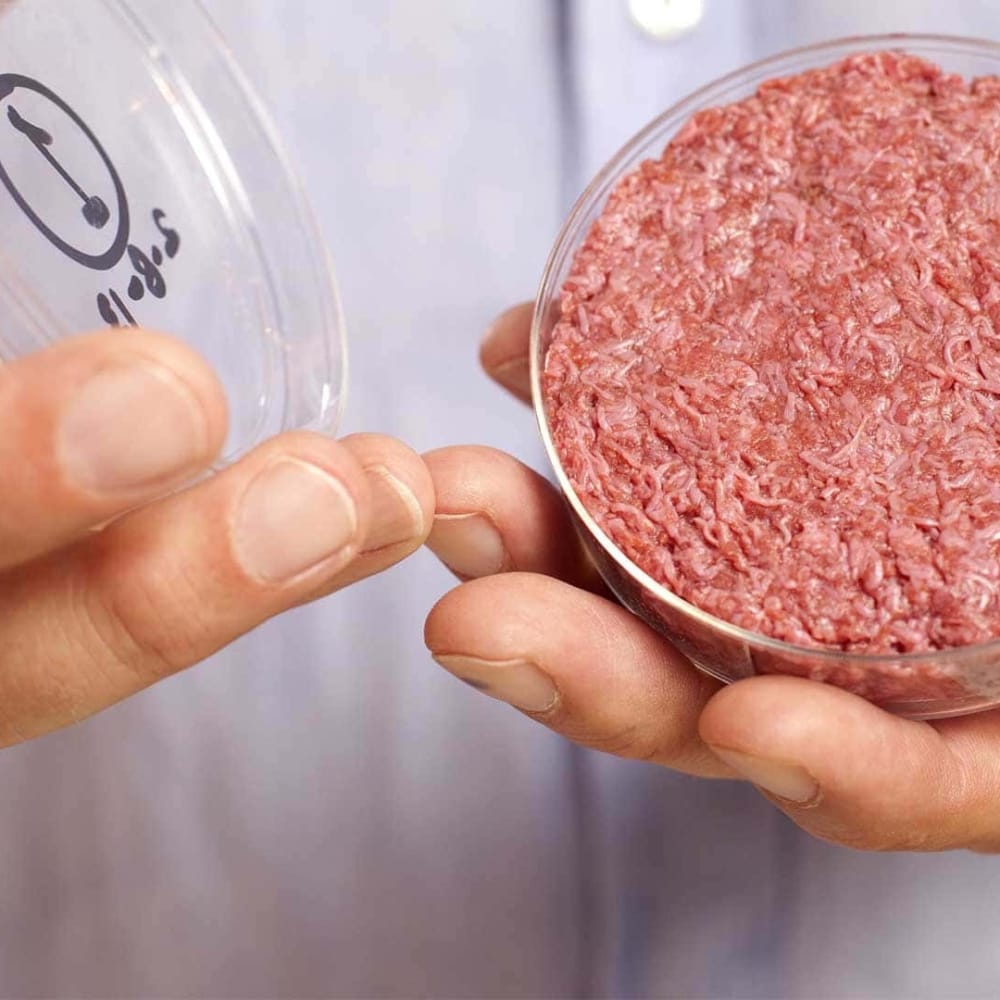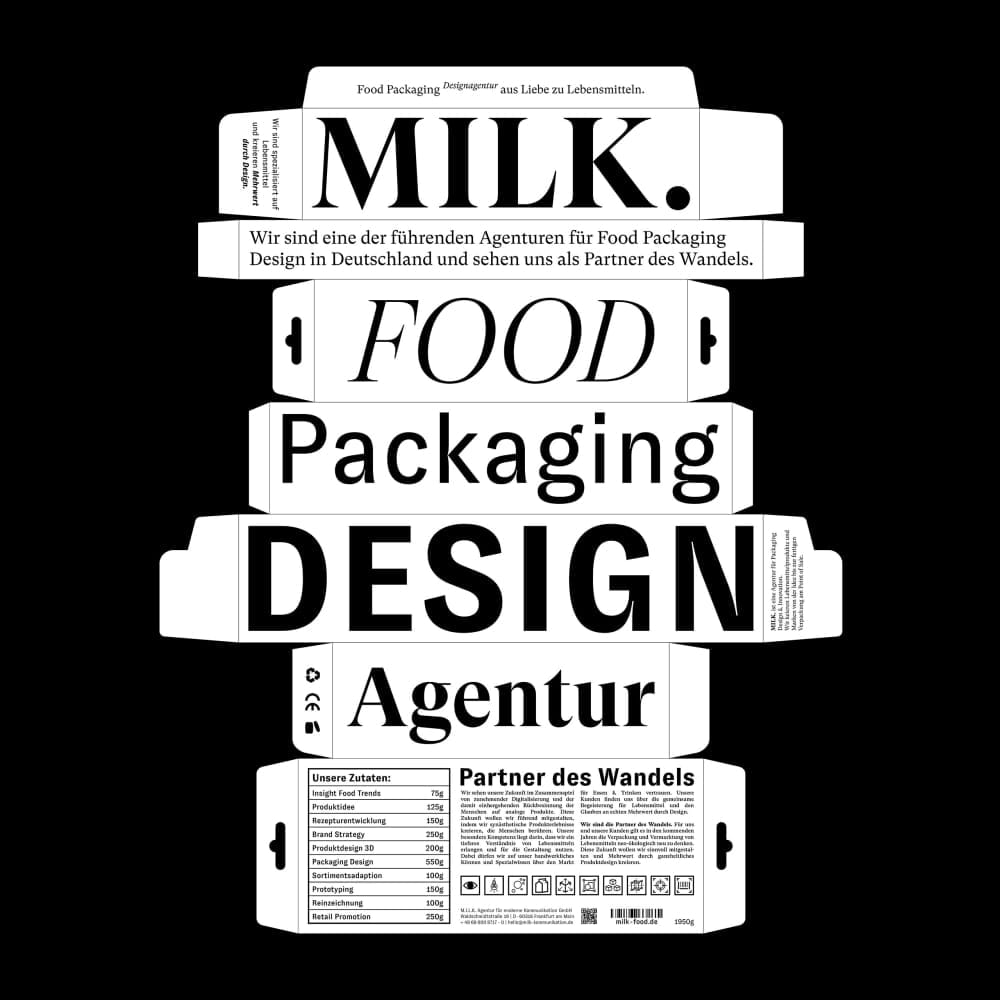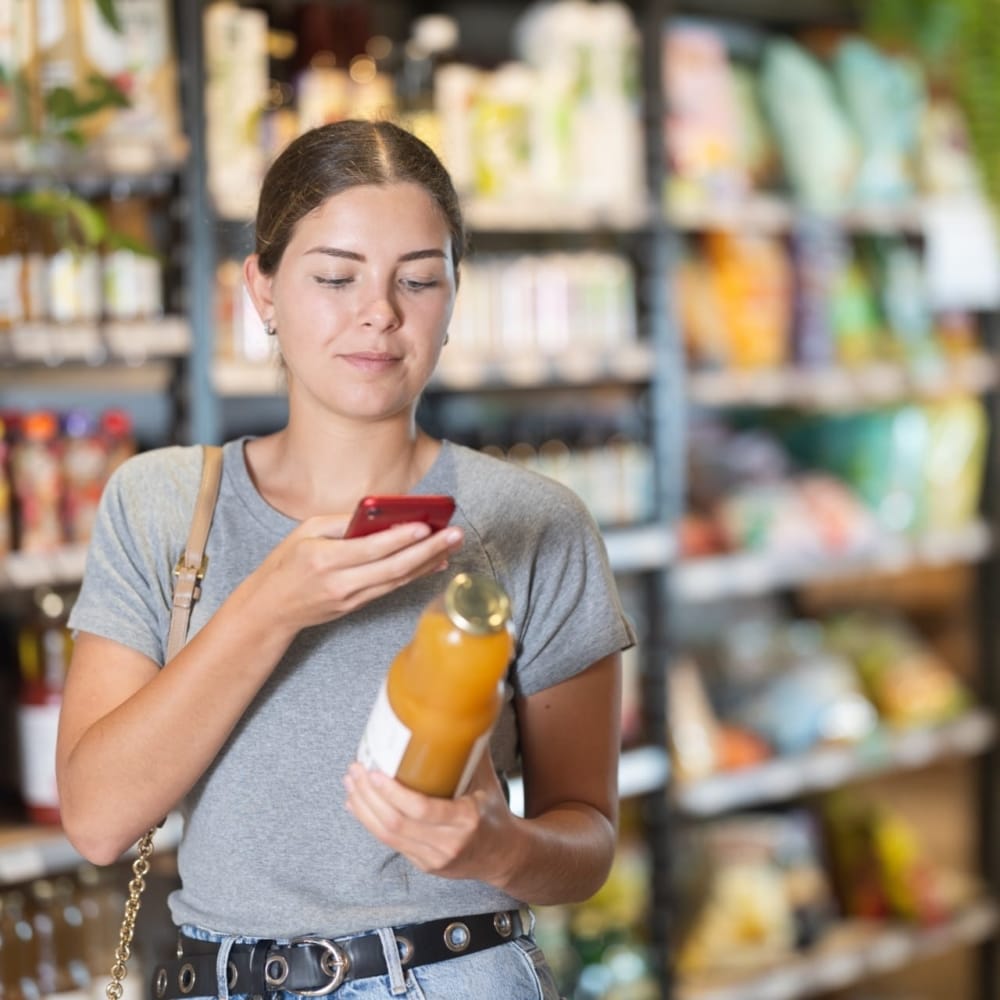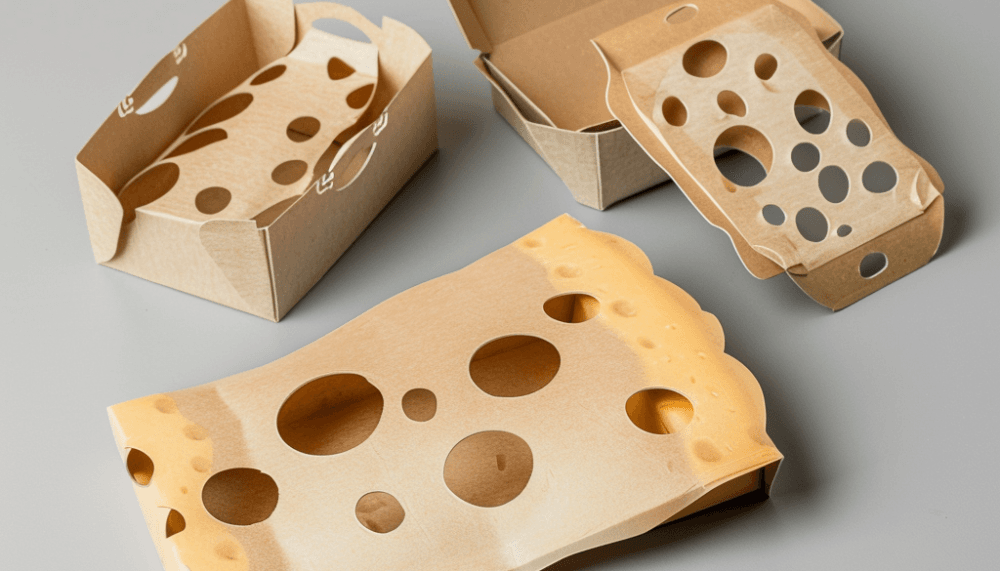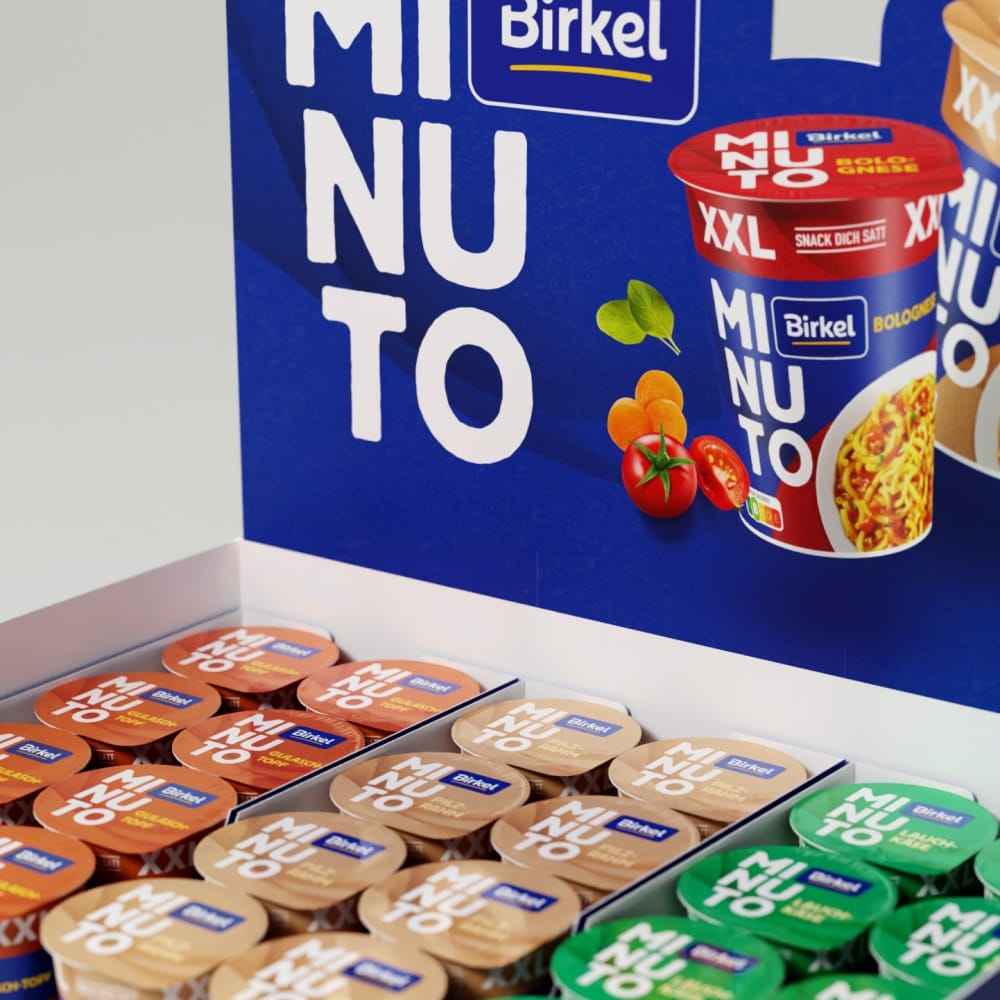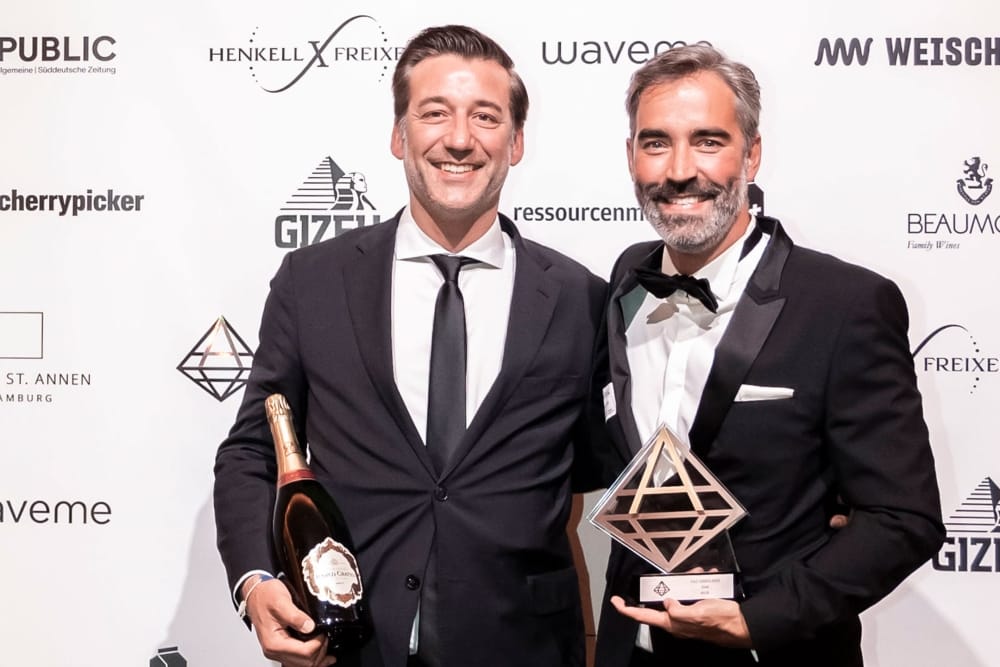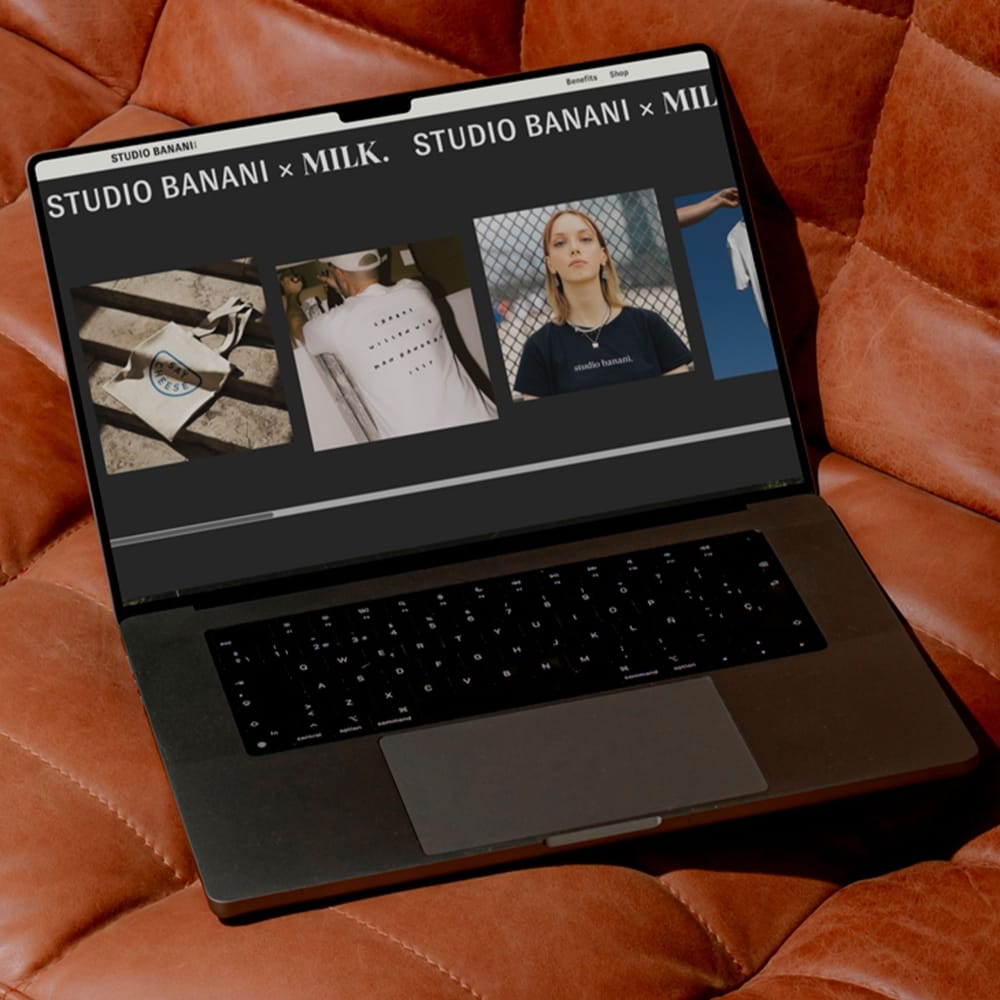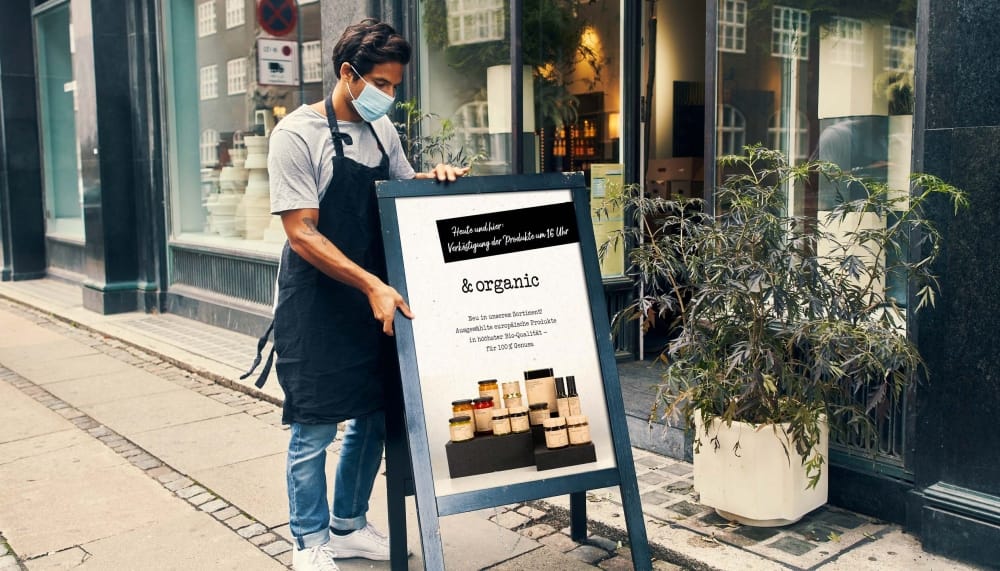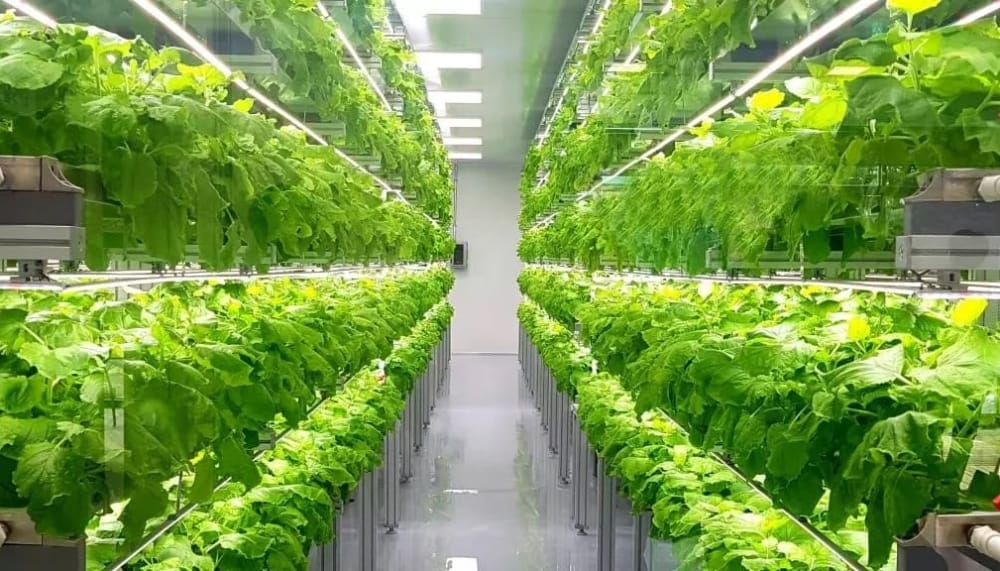Insights for everyone: Food Packaging Trend Radar, Material Glossary and our milkshake magazine. Dear foodies, marketeers and design people – we wish you bon appétit.
- Regional Food: Food from the region
-
Regional Food The formula “regional is the new organic” has long since arrived in the marketing departments and thus communication documents of food manufacturers and retailers. And not by chance: As a reaction to the increasing globalization and industrialization of our food, the longing of many consumers for familiarity, naturalness, authenticity & security was fed. […]
Learn more - Zero Waste: Surplus food as a business model
-
Zero Food Waste Food waste is one of the biggest societal challenges of the 21st century and is therefore also increasingly the starting point for new business models, with startups turning the problem into an innovation. Often sorted-out food is still perfectly edible, which is why it is becoming more and more common to redistribute […]
Learn more - Fast Good: Fast Food Becomes Healthier
-
Fast Good Fast Good describes the new pace of quality in out-of-home catering, as fast food has long since become a fundamental part of everyday urban eating. But nowadays people don’t just want to save time when eating, they also want to eat healthily more and more often and enjoy their food to the full. […]
Learn more - Meet Food: More proximity to the product
-
Meet Food More and more people want to perceive food sensually. The evolution of consumers into prosumers as a result of the need for more transparency is in full swing: What am I actually eating? Where does it come from? What is it composed of? How is it processed, prepared – and above all, how […]
Learn more - Transparency: More transparency for more appreciation
-
Transparency Communities, collaborations and cooperations will become more and more important in the future thanks to the new connectivity. This goes hand in hand with the demand for the best possible transparency about food, its origin and production, and the actors involved. The Corona pandemic, in particular, has fueled consumers’ need for safety by providing […]
Learn more - Fermentation: the rediscovery of an ancient cultural technique
-
Fermentation Not everything needs to be redone if it worked really well before. What was used centuries ago to preserve food has now become a hipster hobby: Fermentation. What has been hinted at over the past few years is becoming more and more of a mainstream phenomenon. The trends around fermentation go far beyond the […]
Learn more - Super plant hemp: from drug to miracle raw material
-
Super plant hemp Alternative dietary methods are enjoying tremendous growth in popularity. The health megatrend in particular has made hemp a shooting star on the market for new products: whether it’s CBD-enriched oils, drinks or food – hemp, the plant that is otherwise more familiar from the intoxicating corner, can now be found more and […]
Learn more - Flexitarianism: meat consumption with more responsibility
-
Flexitarianism In Germany and in many neighboring European countries, we have reached “peak meat,” which means that meat consumption is stagnating at a level (which is still far too high from an ecological and health point of view) or is even declining slightly. One reason for this is the trend toward flexitarianism, or part-time vegetarianism. […]
Learn more - Healthy Hedonism: indulge healthily
-
Healthy Hedonism With more and more food innovations and increasing pressure for suppliers in the industry, it is becoming clear that good nutrition can be both healthy and enjoyable. The partial departure from a purely functional understanding of health is in full swing and is leading to a new pleasure in eating even in the […]
Learn more - Functional Food: Eating for Self-Optimization
-
Functional Food You are what you eat! The functional food trend makes this statement its own and promises true peak performance for the individual with appropriate nutrition. One thing is clear: foods that promise an additional health benefit (bring with them a “promise of efficacy,” so to speak) are an enormous growth market. Probiotics are […]
Learn more - Snackification: Food on the go
-
Snackification The megatrends of individualization, connectivity and, above all, mobility and new work have led to a global society that is not only increasingly on the move virtually, but also quite physically – with elementary effects on our food culture. More mobile lifestyles require more mobile dining solutions, which is why the out-of-home market was […]
Learn more - Circular Food: Food Recycling and Upcycling
-
Circular Food In addition to the redistribution of food surpluses and leftovers, the topic of recycling or upcycling is also gaining in importance. Leftover food or by-products and side streams of food production and processing serve as raw materials for entirely new, usually higher-value products. Whether it’s misshapen fruit that Dörrwerk turns into fruit paper, […]
Learn more - Plant-based food: Animal products become plant-based
-
Plant-Based Food Plant-based animal substitutes, especially for meat, are booming. At the latest after the brilliant stock market launch of the U.S. company Beyond Meat, we know: The future is(s) plant-based. The plant-based flagship from Germany – Veganz – also got off to a successful start on the stock market. Every week, therefore, one may […]
Learn more
- Clean Meat: Meat & Fish from the Lab
-
Clean Meat Artificial meat from the laboratory will fundamentally revolutionize meat consumption. Technological development makes it possible for people to eat animal meat without having to kill an animal. As research progresses and more and more companies (from the U.S. to Israel) put it into practice, it is increasingly possible to reach price segments that […]
Learn more - Precision Fermentation: Milk proteins through fermentation
-
Precision Fermentation After various companies have managed to crack the “meat code” plant-based and now successfully imitate burger patties, chicken schnitzel or gyros with mainly soy and peas, it is now on to the other foods of animal origin such as milk, ice cream, yogurt and cheese. An extremely promising process here is “precision fermentation”, […]
Learn more - Plant-based Food 2.0: Eggs without chickens
-
Plant-Based Food 2.0 The question of which came first – chicken or egg – will probably soon no longer arise. Various trend researchers and agencies predict that 2021 will be the year in which egg substitutes become the fastest-growing plant-based alternative food worldwide. By mid-2020, U.S. market leader JUST Egg had already sold the equivalent […]
Learn more - Brutal-Local: Regional food on the next level
-
Brutal Local The regional-food trend jumps to the next evolutionary stage – from regional to brutal-local. More and more restaurants are following in the footsteps of the pioneers of northern cuisine around Noma in Copenhagen and cooking exclusively with food from the respective region. Consumers are also placing more and more value on increased quality […]
Learn more - Reverse engineering food: molecular replication of foodstuffs
-
Reverse Engineering Food This is not about the world of molecular cuisine, which already had its hype in the 1990s. Rather, it is about a science and technology sector in which foods such as. beverages are not made from the classic raw materials such as grain, grapes or beans, but from compound plant molecules. Reverse […]
Learn more - Food Pairing: Taste from the drawing board
-
Food Pairing The fact that cheese and wine go wonderfully together has become something of a culinary no-brainer. But in the future, with increasing food diversity and rising curiosity on the part of consumers, the scientifically supported combination of foods and their “flavor pairs” will become more and more common. Food pairing reveals an almost […]
Learn more - Algae: Superfood from the sea
-
Algae Today, we already know algae as a shell and accessory for sushi or in pill form as a dietary supplement from the Internet or health food store, but the culinary, nutritional and above all marine-agricultural or “sea-economic” potential is far greater. Algae will therefore have a great career on our plates in the coming […]
Learn more - Fusion Food: Global & regional go hand in hand
-
Fusion Food The regional food trend is undoubtedly strong and will continue to gain strength, but that does not mean that we will all become locavor:ins in the future (i.e. eat only locally or regionally produced and prepared food). On the contrary, every trend generates a counter-trend, which is why the longing for the regional […]
Learn more - Aquaculture: seafood from the pool
-
Aquaculture What can responsible fish consumption look like to combat overfishing? Closed aquaculture, where animals such as brine shrimp, seafood and saltwater fish are kept and farmed in a species-appropriate manner without the use of antibiotics or chemicals, is one of the answers to the major problems facing the world’s oceans. The recirculating systems are […]
Learn more - Local Exotics: Culinary delights between home and faraway places
-
Local Exotics The lockdowns in the wake of the Corona pandemic have not only further reinforced the importance of local food production, but at the same time have created a new yearning for culinary discoveries and exotic delights. Local Exotics promise to resolve this contradiction in the future. New technologies such as aquaponics and indoor […]
Learn more - Curated Food: Pre-selection instead of overflow
-
Curated Food As the abundance and variety of food products in our supermarkets and online stores increases, so does a basic human need: orientation. And the more we are overwhelmed by choice (cf. Paradox of Choice), the more we long for providers and offers that make our consumption decisions easier. The answer lies in the […]
Learn more - Climatarianism: Food for the climate
-
Climatarianism It is true that the idea of a dietary (re)form for the purpose of climate protection was launched about half a decade ago. But the resounding success in the social center will still take a few years. However, it will then be quite normal for consumers to increasingly consider the well-being of the planet […]
Learn more
- Precision Food: Hyper-personalized nutrition based on DNA
-
Precision Food The megatrend of individualization is permanently changing our diet from “one-food-fits-all” mass consumption, to personalizable soft drink cans and self-assembling muesli mixes, to hyper-personalized diets. Nutrigenomics and DNA profiling, as well as predictive analytics and machine learning, are expected to help enable perfectly-tailored nutrition, precision nutrition. More and more often we read slogans […]
Learn more - 3D printed food: Food from the printer
-
3D Printed Food From “to go” to “to print”: The snack culture from the 3D printer will replace today’s fast food the day after tomorrow and thus primarily revolutionize the system gastronomy. Patties and entire burgers are then simply prepared by printer, using a food printer to produce a piece of meat from scratch from […]
Learn more - Ento Food: Insect breakthrough
-
Ento Food Almost one-third of the world’s people eat insects. In Western culture, the sight still leads to emotional reactions that can only be located somewhere between disgust and restrained curiosity. But due to the megatrends of sustainability and health, we are now finding more and more entrepreneurs, restaurateurs and consumers in this country opening […]
Learn more - Real Omnivores: Potential futures become a future
-
Real Omnivores Real omnivores are the eaters of the future. Tech-savvy and much more open-minded about new developments in the food sector than other types of eaters, the “real omnivores” are looking for more options for a balanced, diverse and sustainable diet that is not only characterized by the omission of foods perceived as problematic […]
Learn more - No-Food-Food: Eating becomes pure nutrient intake
-
No-Food-Food What we already know from Silicon Valley or the spaceship could become the culinary routine for many people the day after tomorrow: People will no longer eat for pleasure, but purely to absorb nutrients. But this also fundamentally changes what we consume. Because when neither the joy of shopping, cooking and eating is a […]
Learn more - CO2 food: food from the air
-
CO2 food Many current food trends can be clustered under the motto “sustainability,” as the need for more sustainable, climate-friendly offerings for a more mindful diet in the sense of the Planetary Health Diet is a major social need right now. But where many companies are trying to reduce CO2 emissions with their offerings, there […]
Learn more
- Ghost Kitchens: Kitchens without a restaurant
-
Ghost Kitchens In the Corona Crisis, power relationships between delivery services and restaurants are being renegotiated. Everyday dining is fundamentally changing with the growing popularity of food delivery services and so-called “dining in,” or eating food cooked by others at home. And in the wake of an increasingly competitive delivery market, “ghost kitchens” (also called […]
Learn more - Work-food balance: upgrade for communal catering
-
Work-food balance Working time is life time. And that is precisely why the corporate dining culture is always an expression of appreciation for employees. The socializing power of food and drink is also becoming increasingly important in companies and businesses. Large corporations such as Google, Spotify, Dropbox and others have led the way: Their company […]
Learn more - Infinite Food: Food is everywhere
-
Infinite Food “Eating is the new pop,” wrote Hanni Rützler a few years ago in her Food Report, alluding to the development that culinary offerings are no longer limited to restaurants. On the contrary, food is always and everywhere as a central component of urban everyday culture and is increasingly leaving the classic food areas. […]
Learn more - Home Kitchen: The kitchen as the center of the home
-
Home Kitchen Since the turn of the millennium, the kitchen has acquired more and more functions in addition to its namesake purpose; it has become multifunctional. Due to changing lifestyles, the classic separation of homes into their one-dimensional functions – sleep, work, eat, rest – has become increasingly obsolete. The kitchen is increasingly becoming the […]
Learn more - DIY Food: Do-it-yourself changes production and consumption
-
DIY Food For a long time, do-it-yourself was seen as a niche counter-trend or reaction to the increasing “convenience” of food and the associated loss of confidence (because the feeling arose that one no longer knew what was actually in the food that one only had to put in the microwave for 2 minutes). Now […]
Learn more - Kitchen Apps: Intelligent cooking, stocking and ordering
-
Kitchen Apps Today, learning algorithms from apps already support us in the kitchen when cooking recipes tailored to our wishes, when stocking and storing, and when reordering new foods if necessary. Here, individualization is paired with networking and, increasingly, sustainability, because often, in addition to personal self-optimization through consideration of individual health goals, the reduction […]
Learn more - Conscious Kitchen: Kitchen becomes mindful
-
Conscious Kitchen Influenced by the megatrends of sustainability and health, the kitchen is gaining a responsible awareness: more than ever, it is becoming an everyday companion that supports people in living healthier and more conscious lives. This is also reflected in the design, materials and furnishings of the “Conscious Kitchen,” as trend researcher Oona Horx-Strathern […]
Learn more - Convenience Cooking: Meal kits for convenient cooking enjoyment
-
Convenience Cooking From Michelin-starred restaurants to young fresh-food startups to established cookbox providers, meal kits, previously a niche concept, have gone mainstream in the Covid 19 era. Restaurants and other companies not only deliver completely ready-made menus, but also specialize specifically in the production of menu components that need to be finalized into dishes at […]
Learn more
- Smartness Everywhere: The kitchen gets smart
-
Smartness Everywhere KitchenAid was just the beginning. Within the next few years, kitchens will become increasingly digitalized, connected and intelligent as part of the connectivity megatrend. Whether it’s a Smart Fridge, Smart Table or Smart Cooking Station, each device communicates with the others and with the user’s smartphone, transforming people in the kitchen from cooks […]
Learn more - Impact Chefs: Women Chefs as Drivers of Change in the Socio-Ecological Transformation.
-
Impact Chefs For some time now, the restaurant industry can be seen as a trend epicenter for social change. In no other food sector do changes take root and make their way into the mainstream faster. And since a large part of the social challenges of the 21st century around climate change, resource scarcity, poverty, […]
Learn more - Vegourmets: Vegetable menu becomes gastronomic standard
-
Vegourmets The popularity of vegetarian and vegan diets has continued to grow in the pandemic – plant-based meals are also increasingly in demand in the delivery market. According to Lieferando, orders for vegan dishes in 2020 increased by 166 percent year-on-year in Germany. Vegetable dishes are not only aimed at vegetarians – on the contrary, […]
Learn more - Gastro Sentiments: AI turns restaurants into trend scouts and setters
-
Gastro Sentiments Programmers call sentiments information with an emotional statement, i.e. texts with emojis, certain hashtags or connotative adjectives and verbs that can be read emotionally. As a result of the fact that food has now become a substitute religion and foodism has led to a vast amount of data (based on online restaurant reviews, […]
Learn more - Virtual Reality Eating: Using Virtuality to Achieve the Ultimate Experience
-
Virtual Reality Eating Restaurants are increasingly permeated by digital technologies. And not only in the “backend”, i.e. invisible to guests, but increasingly also in the frontend and thus in the middle of the guest area. Technology-savvy restaurant operators are turning to virtual reality goggles (i.e., glasses that transport their wearers into a real-time computer-generated virtual […]
Learn more - The illuminated plate (MILK. soulplate)
-
Soon, kitchens and restaurants could find enlightenment via novel plates. The first illuminated plate for home and catering is called “soulplate” and not only makes our food shine beautifully, but also teaches us to be mindful of the precious food in front of us.
Learn more
- No-Kitchen-Living: Kitchens disappear from homes & offices
-
No-Kitchen-Living The snackification trend resulting from increasingly mobile lifestyles is leading to homes and offices being planned and built entirely without kitchens. The reason for this is that people simply no longer need them. People eat on the train, in the office, in the park or in a restaurant. Takeaways are a central part of […]
Learn more - Robot Kitchen: Full automation of the kitchen
-
Robot Kitchen A balanced diet will continue to play a major role in the future, especially in view of the further increase in diseases of civilization such as obesity and diabetes. But where ready-made meals and convenience food lack freshness and delivery services are more frequently criticized due to social practices, kitchen robots represent a […]
Learn more - Big Retro: Craft & Tradition Experience a Revival
-
Big Retro As kitchens at home and in restaurants become increasingly digital and smarter, a great retro yearning is developing and old and almost forgotten cooking practices and recipes are experiencing a renaissance. Both residential and restaurant planners are developing entirely analog concepts and banishing “smartness” from kitchens and dining rooms. As long as there […]
Learn more
- E-food: online food trade booming
-
E-Food In the wake of the Corona crisis, the megatrend of connectivity really took hold in the grocery trade and finally made Germans order groceries online. Where online retail as a whole grew by just under 15 percent in 2020, online grocery retail grew by a whopping 67 percent to 2.67 billion euros – no […]
Learn more - #foodporn: nutrition goes viral
-
#foodporn Social media have become part of everyday culture, especially among younger generations, and the topic of food is one of the most discussed. Whether it’s sourdough bread, baked feta pasta or squashed potatoes, these and other food hypes are still going viral on social networks. Particularly via TikTok, the little films have also spread […]
Learn more - Instant delivery services on wheels: Let’s go shopping quickly
-
Instant delivery services on wheels Turning a crisis into a virtue – or even into a sometimes enormously successful business model. More and more startups want nothing less than to revolutionize the way we shop for food. Via app, groceries can be ordered at supermarket prices and then delivered by bike within just 10 minutes […]
Learn more - Urban Gardening: Self-sufficiency in the City
-
Urban Gardening Driven by a young generation of city dwellers who are increasingly seeking a balance to their stressful new-work day at the laptop, concepts ranging from open-source gardens to indoor vegetable gardening are growing in popularity. Food production is unceremoniously organized and celebrated on rooftops, brownfields, balconies and terraces, primarily to satisfy the increased […]
Learn more - Water-Energy-Food: Symbiotic Systems of Transformation
-
Water-Energy-Food The increasing complexity of the social and economic system with further increasing interdependencies of the individual subsectors (water, energy, agriculture, transport, etc.) increasingly requires systemic approaches to transformation. According to the United Nations, the water-food-energy nexus is key to the sustainable development of our societies. Demand for all three is increasing, driven by a […]
Learn more - Political Food: Food becomes (socially) political
-
Political Food In terms of value orientation in society, the Corona pandemic has only reinforced what was already apparent: for consumers, the values and attitudes of the producers and companies whose products they buy are becoming increasingly important. Food is becoming increasingly politicized in light of the increasingly obvious and frequently discussed societal challenges around […]
Learn more - Fully automated mini market: 24/7 self-service shopping
-
Fully automatic mini market People’s changing consumption, lifestyle and working habits are putting stationary retail under massive pressure. In the course of digitization, entirely new concepts are to make grocery shopping easier and more flexible for customers, especially for staple foods. German grocer Tegut designed the “Teo” concept for this purpose, a mini-market equipped with […]
Learn more - Crowdfarming: For more proximity between producer and consumer
-
Crowdfarming Crowdfarming (translated as “swarm farming”) wants one thing above all: to value food more again through a newfound closeness between producers and end customers. The idea behind it is simple: people adopt fruit trees, animals or vines and the farmers deliver apples, cheese or wine directly to their door. This special form of sponsorship […]
Learn more - Automation in the countryside: regional products directly from the producer
-
Automation in the countryside The trend toward more regional food continues. Particularly in times of crisis, in times of great uncertainty, people return to the familiar, the regional, the transparent. In the meantime, it is increasingly possible to buy products directly from producers and to do without middlemen – and this is not only more […]
Learn more
- Self-Driving Food: Autonomous Delivery by Robot
-
Self-Driving Food More and more people order food and dishes online and then have them delivered by delivery service. Both retailers and restaurants are already testing self-driving delivery robots. In the future, once the technology has matured even further and liability issues have been clarified, it will be quite normal for autonomous robots in the […]
Learn more - Next Level Transparency: Transparent Value Chains Thanks to Blockchain
-
Next Level Transparency Thanks to modern technology and increasingly powerful consumers, we are entering a new era of transparency in the food industry. Origin of raw materials, processing, ingredients, distribution and sale: after decades of ignorance and various food scandals, consumers want to know everything! And food suppliers, for example, can use blockchain solutions to […]
Learn more - Zero Food Waste Society: Intelligently waste-free
-
Zero Food Waste Society If global food waste were a state, it would be the third largest emitter of greenhouse gases after China and the United States. The many startups that use food waste and surpluses as the basis for their business models are increasingly bringing the issue to the forefront of society and thus […]
Learn more - Extended Reality Shopping: Retail and Shopping Are Going Digital
-
Extended Reality Shopping Digitization is not stopping at retail either – on the contrary: extended reality applications, i.e. the entire range of virtuality, such as the “virtual world”, are becoming more and more popular. Virtual Reality (VR), Augmented Reality (AR) or Mixed Reality (MR), are traded as “the next big thing”. But it is also […]
Learn more - Between craft & industry: digitization blurs the boundaries of food production
-
Between craft & industry In the past, the structures were somehow clearer: On the one hand, there were the craftsmen, who mostly produced food without much technical aids, and on the other hand, there was the industry, in which, driven by the capitalist efficiency paradigm, food was produced in as short a time as possible […]
Learn more - Gene-edited food: Food becomes more climate resilient
-
Gene-edited Food Climate change and associated extreme weather events and changes in temperature and precipitation are increasing pressure on agricultural productivity as well as overall food security. Especially since the pace of global warming far exceeds that of natural plant adaptation. Projected declines in yields with parallel worsening biodiversity loss and resource scarcity are leading […]
Learn more - Vertical Farming: Farming in a high-rise building
-
Vertical Farming More than half of the world’s population already lives in cities, and according to UN model calculations, this figure will rise to more than two-thirds by 2050. Providing these people with fresh, healthy food is one of the great challenges of the future. Urban food in the form of vertical farming offers the […]
Learn more
- Robot Farmers: Autonomous food production
-
Robot Farmers In view of a growing world population and the associated increase in food demand, as well as the simultaneous decline in the availability and fertility of soils and land, increasing agricultural productivity is a top priority. Increases in effectiveness and efficiency potential are becoming apparent here primarily due to the increasing technologization and […]
Learn more - Food production under water: algae and sea
-
Food production under water Seas, rivers, lakes and ponds open up new culinary perspectives. In the coming years, algae will also make a career for themselves on our plates as a particularly nutrient-rich vegetable. Not only in the almost “classic” form as a wrapper for maki and accessory for sushi or in pill form as […]
Learn more - Telemedicine in the barn: health tracking for animals
-
Telemedicine in the stable According to Regensburg-based startup Futurofarming, 80 percent of calves become sick within the first ten days of life and about 10 percent of animals die from disease. And so technological change has made it possible for telemedicine (basically diagnostics despite spatial separation) to now also find its way into the barn, […]
Learn more - Personal Food Factories: Food Production for the Individual
-
Personal Food Factories The megatrend of individualization means that our diets are becoming increasingly varied and individualized. But what was limited to the packaging a few years ago (the eternally identical cola with its own name) is now also increasingly reflected in the composition of the food itself (e.g. sugar-, gluten-, meat- or lactose-free). The […]
Learn more - Food Download: Teleportation replaces delivery service
-
Food Download 3D printing technology, already the first gadget to give techies and nerds warm hearts, could in the future turn the way we produce, transport and market our food upside down. If we succeed in encoding food and its tastes, smells, textures, etc. with the help of complex algorithms, culinary digitization will continue to […]
Learn more - Meta Food: The food experience becomes virtual
-
Meta Food Facebook’s Mark Zuckerberg recently announced his plan to hire 10,000 people in Europe to develop a new artificial intelligence (AI) company, the Metaverse. The goal is a borderless 3D digital world that can be accessed via a virtual reality (VR) headset, and in which people can go to concerts, to the park, or […]
Learn more - Next-Level Greenhouse: Agriculture of the Future
-
Next Level Greenhouse Industrial agriculture has run into ecological and social dead ends here and there, which is why there are more and more new visions, concepts and designs to completely rethink agriculture. Sustainability is a key driver here, which is intended to bring tomorrow’s agriculture into harmony with nature and society. The Except Integrated […]
Learn more - Predictive food analytics: When machines start to taste
-
Predictive Food Analytics The new or further development of food is one of the great Pandora’s boxes of the food industry. What is a real trend and can establish itself and what fades as pure hype after only a few months and disappears from the market again? For decades, the innovation and marketing departments of […]
Learn more
- Fiberization: fiber casting as a rising star?
-
Bye-bye injection molding, hello fiber molding. The triumph of paper is unstoppable. Not only do consumers prefer fiber-based solutions (although not always rightly so), but so does the EU. While the plastics industry moans about minimum recycled content and mandatory recyclability, paper manufacturers are getting off lightly in the upcoming PPWR. And that’s not all […]
Learn more - Reduce: further resource conservation through packaging optimization
-
Smart aluminum strips instead of plastic cover. Sometimes all it takes to achieve greater sustainability is a little “twist”. Reduction can be achieved not only by replacing materials and hybrid solutions, but also through smart product design. Image source: John West Like last year’s winner of Packaging Europe‘s“Sustainability Awards“, the canned tuna can from John […]
Learn more - Reduce: Minimal use of plastic thanks to hybrids
-
The best of both worlds: Cardboard hybrids for plastic reduction. Image source: SEALPAC Less is more is the principle of the “Reduce” trend. With hybrid packaging, attempts are being made to reduce the proportion of fossil materials in particular through smart material combinations. Such as the “eTray” from SEALPAC. This is a prefabricated cardboard tray […]
Learn more - Reuse: reusable offers in retail and gastronomy
-
Reusable instead of mountains of garbage: McDonald’s makes the switch. Fast food restaurants, as places of quick consumption, are rarely a role model for sustainable solutions. The French McDonald’s branches no longer conform to this cliché – albeit not entirely voluntarily. Image source: Elium Studio Since January 1, 2023, all catering establishments in Germany have […]
Learn more - Reuse: reusable takeaway offers
-
Reusable take-away packaging in the catering industry. Image source: Rebowl Reusable deposit systems such as those from REBOWL provide catering establishments with environmentally friendly take-away boxes. A deposit must be paid and the box can be returned afterwards. The aim is to reduce disposable packaging and prevent waste. Since January 1, 2023, all catering establishments […]
Learn more - (Design for) recycling: material reduction
-
As little plastic as possible – with as much product protection as necessary. The industry has been working on technical solutions to reduce packaging material for years. The primary goal: cost savings with the same function. This development has saved large quantities of plastic compared to previous years. The popular example of minced meat tray […]
Learn more - (Design for) recycling: adhesives and printing inks as hidden potential
-
Underestimating components for better recyclates. When Design for Recycling is discussed, one crucial topic is often overlooked: the choice of the right adhesives, inks and finishes. They have a significant influence on the quality of recycled materials – whether plastics or paper. To solve the problem, you could dispense with labels altogether, as shown here […]
Learn more - (Design for) Recycling: mono plastic
-
Packaging 96% recyclable*. Image sources: Rügenwalder Mühle *The packaging shown consists almost exclusively of polypropylene (PP), from which high-quality recycled pellets can be obtained. The label was also changed from paper to PP in order to achieve the purest possible sorting results in the recycling process. All homework on the part of the manufacturer has […]
Learn more - Fiberization: Barrier papers as a plastic substitute
-
The triumph of fibers. Two major influencing factors have led to plastic packaging being increasingly replaced by cellulose-based alternatives. On the one hand, paperization or fiberization is driven by consumer demand, On the other hand, the paper industry is the big winner of the new PPWR regulation. While the plastics industry is being penalized and […]
Learn more - Compostable: packaging made from mushroom-based material
-
Grown into shape: the shipping packaging of the future. It’s not just since the pandemic that huge quantities of food have been delivered to doorsteps – triggered by countless online orders. Such deliveries could become more sustainable thanks to solutions such as MycoComposite™ from manufacturer Ecovative, which replaces stryopor with cultivated mushroom-based material. Image source: […]
Learn more - Compostable: degradable film
-
An old acquaintance in a new guise. Image source: The Nu Company Film made from cellulose hydrate (better known as “cellophane”) was introduced to the market at the beginning of the 20th century and is one of the oldest packaging materials for food products. The material obtained from wood is now experiencing a renaissance in […]
Learn more - Digitalization: The comeback of the QR code
-
Scanning for the circular economy. Corona has given an old acquaintance a new lease of life: the QR code, which was thought to be dead. It is currently still placed on packaging on a voluntary basis to provide consumers with additional information. However, new EU regulations could give the QR code renaissance an additional boost. […]
Learn more - Digitalization: Tracking through RFID technology
-
Small chip, big effect. Contactless identification of packaging. Digitalization does not stop at the packaging industry. RFID tags (Radio Frequency Identification) are now widely used and have become increasingly important, especially in the context of logistics optimization. The wafer-thin chips, which are incorporated into the product, enable efficient management throughout the entire supply chain. RFID […]
Learn more
- Digitalization: The “digital twin” provides information on green claims and more
-
New laws such as the PPWR and the Green Claims Directive are intended to ensure that the circular economy is promoted for packaging and that consumers are better informed. In order to make the information needed to achieve these goals available, the “Digital Product Passport” (DPP) is to be introduced from February 2027. It obliges companies to make information on raw materials, production processes and the recyclability of a product available digitally.
Learn more - PPWR, ECGT, Green Claims: New packaging laws come into force
-
If you don’t want to hear, you have to feel. At least that’s how the EU sees it when it comes to sustainable packaging and packaging communication. With a series of laws and directives as part of the European Green Deal
Learn more
, politicians are trying to promote a circular economy and reduce environmental pollution. - Compostable: Back to cellulose
-
Packaging made from organic waste. Image source: MakeGrowLab MakeGrowLab’s packaging made from woven biowaste consists entirely of cellulose. The so-called Scoby is 40 times more durable than paper and is compostable thanks to its natural components. The water vapor and oxygen barrier properties are promising. Shampoos, soaps and foodstuffs such as vegetables and coffee have […]
Learn more - Reduce: Unpacked – good idea, big challenge
-
Spray instead of packaging California-based startup Apeel Sciences developed an edible protective spray for fruits and vegetables derived from food scraps. This tasteless and low-calorie variant, due to its waterproof molecular structure, primarily serves to preserve the food, thus allowing protection from moisture and gases that continue the ripening process. Can ideas like this give […]
Learn more - Reuse: the renaissance of the refill bag
-
Permanent packaging with re-fill offers. What never really caught on “yesterday” could become an important pillar in the avoidance of packaging material “tomorrow”: the concept of refillable bags. This trend thrives on an e-food market that enables subscription models for reordering products. Image source: Blue Farm When my oat drink powder arrives with the next […]
Learn more - (Design for) Recycling: Circular food packaging
-
Finally, true closed-loop systems for plastic food packaging. We expect EU approval for post-consumer recycled material (PCR) made of PE and PP for direct food contact in the near future. This would be the necessary step so that optimized sausage packaging, as in the example shown here, could finally become sausage packaging again. Thanks to […]
Learn more - Fiberization: Beverage bottle made of paper
-
The triumph of fibers continues: the paper bottle. Image source: Paboco The “Paper Bottle” drinks bottle from Paboco is made from wood fibers obtained from sustainably managed forests. A barrier protects the material inside the paper bottle from liquid by making the material impermeable to water vapor and oxygen. While these were still made of […]
Learn more - Compostable: bioplastics really do break down
-
Problem biodegraded. Will our current problems with the disposal of bio-based plastics soon be a thing of the past? Consumers and disposal companies have learned quickly, but the majority of bioplastics are still sent for thermal recycling. Widespread use is faltering – where is the journey going? Image source: traceless The Nova Institute and European […]
Learn more - Digitalization: Holy Grail 2.0
-
Digital watermarks for effective recycling of plastic packaging. We have been closely following this trend since our first attempts at digital watermarking for smart packaging. We ourselves were involved in the early implementation of the NETTO brand discounter with the Digimarc and have supervised various design projects. However, the full potential of the idea only […]
Learn more
- Enforced reduction: whoever produces waste pays
-
A city without waste. The Italian town of Capannori near Lucca has only 50,000 inhabitants, but has achieved something that many large cities dream of. After the construction of a waste incineration plant was prevented in 2007, the citizens decided to become the first“Zero Waste City” in Europe. A whole range of measures were introduced […]
Learn more - Convenient Reuse: The milkman returns
-
Closed loop for everything? Image source: TerraCycle As part of a project called Loop, Procter & Gamble, Unilever, Nestlé, PepsiCo, Danone, Mars Petcare, Mondelēz International and other consumer goods giants are working together with the startup TerraCycle on a possible solution to limit waste in the future. This is a whole new way of shopping […]
Learn more - Real Circularity: The era of pool systems
-
Design for recycling: Maximum standardization Within our agency and with our customers, there are always two opposing camps when it comes to the question of perfect packaging: The advocates of aesthetics argue in favor of “design for selling”, while the ecologists among us demand “design for recycling”. While the former aims to stand out with […]
Learn more - Further Fiberization: A world with minimal fossil resources
-
Many consumers would like to see fossil plastics banned for good. However, we are still unable to do without plastic in many areas – for reasons of hygiene, product protection or cost. The eco-balance of some plastic packaging is also surprisingly positive, even compared to paper.
Learn more - Better than Compostable: Zero Waste 2.0
-
Nose to Tail Packaging. Image source: Lactips Lactips is an edible plastic made from milk protein and produced in the form of pellets. The production is an industrial process that allows rapid production in large quantities. The thermoplastic, water-soluble pellets dissolve in both hot and cold water and are completely degradable. They also have excellent […]
Learn more - Digitalization: analogue and digital shopping experiences merge into one another
-
The future of grocery shopping – a hybrid of analog and digital. The supermarket of the future combines the physical with the digital world. Information about the products is presented on large interactive surfaces. They respond to gesture control from customers. Thus, price information as well as country of origin, nutritional information, similar products and […]
Learn more
The future of food and its packaging.
We design the brands of today for a better tomorrow and keep an eye on the day after tomorrow. It’s about more sustainable food and packaging solutions in the context of real transformation through creativity – the new superpower in the knowledge age.
Discover innovative packaging materials.
Our self-image goes far beyond that of other branding & packaging design agencies: we accompany our clients as partners in change and are happy to tickle their weak points for more progress. We have also invested in our own tools so that we can meet our clients at eye level when it comes to more sustainable packaging solutions for food.
Would you like a little more?
Our milkshake magazine is packed with exciting stories away from the day-to-day business. We invite you into the future of food packaging.
